1720s in archaeology
| Table of years in archaeology |
|---|
| Related time period or subjects |
| Art Archaeology Architecture Literature Music Science more In Template:Year nav topic: extra parameters: science |
The decade of the 1720s in archaeology involved some significant events.
Explorations
- 1722: Dutch explorer Jacob Roggeveen arrives at Easter Island.
Excavations
- Formal excavations continue at Pompeii.

1722: Easter Island.
Finds
- 1727: Gilt bronze head from cult statue of Sulis Minerva from the Temple at Bath, England, found by workmen excavating a sewer.
Publications
- 1723: Antoine de Jussieu publishes De l'Origine et des usages de la Pierre de Foudre on the origins of fossils, prehistoric stone tools and meteorites.[1]
Other events
Births
- 1721: Nicholas Revett (died 1804)
- 1726: October 12 - Pierre Henri Larcher (died 1812)
- 1729: 25 September - Christian Gottlob Heyne, German archaeologist (died 1812)
References
- ↑ "Les pierres de foudre". Retrieved 2011-10-18.
| Preceded by 1710s in archaeology |
Archaeology timeline 1720s |
Succeeded by 1730s in archaeology |
This article is issued from Wikipedia - version of the 7/27/2016. The text is available under the Creative Commons Attribution/Share Alike but additional terms may apply for the media files.